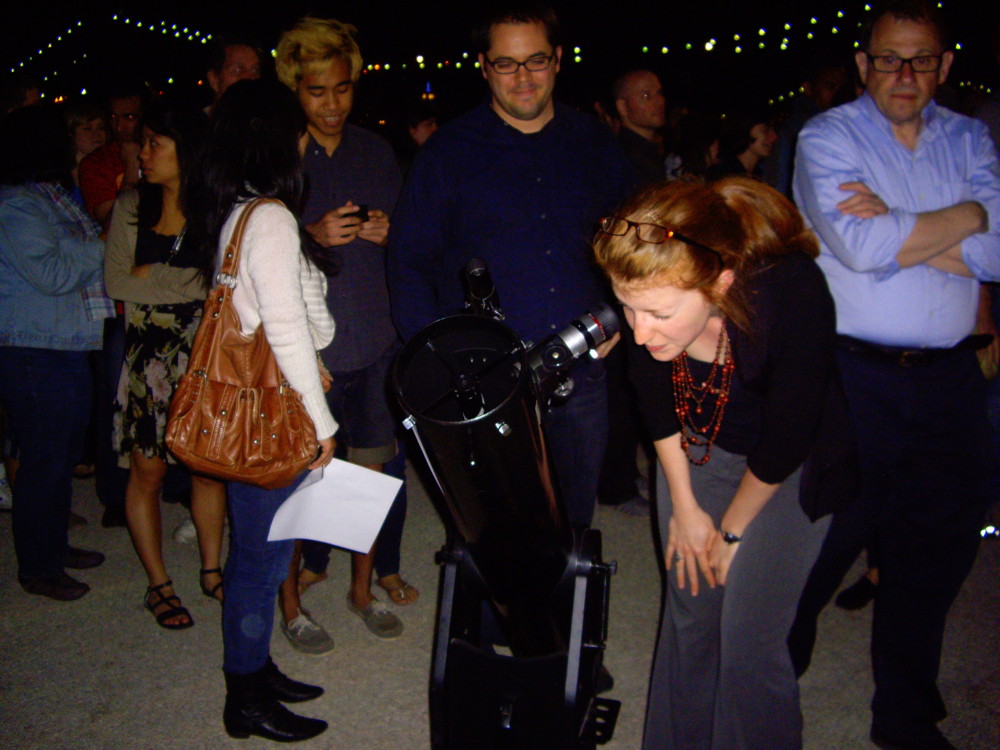When New Yorkers Look Up: Skywatching in the Big Apple

NEW YORK — New York City is a great place for spotting movie stars. As for the celestial ones, though, not so much: The night sky above the city that never sleeps doesn't get very dark. But that fact doesn't keep diehard skywatchers from looking up.
"Right now there aren't very many stars visible," Linda Prince, an amateur astronomer from Long Island, told SPACE.com. "Just a handful here."
Prince was one of approximately 500 stargazers on the banks of New York's East River Friday night (June 3) for "A Night of Stargazing at Brooklyn Bridge Park," an event held as part of the 2011 World Science Festival. Attendees waited in long lines for the chance to look through telescopes pointed at the few celestial objects that did show themselves — including the bright stars Vega and Arcturus, and the ringed planet Saturn, which for obvious reasons turned out to be the crowd favorite.
"I saw stars on one telescope and the planet of Saturn on another, which was amazing," said Julie Errico of Brooklyn. "A little tiny, but I saw the rings and everything, so that was cool." [Photos: The Rings and Moons of Saturn]
Siblings Patrick and Grace Cognato made the trek to Brooklyn all the way from Staten Island to look through the telescopes. "We saw the rings of Saturn and we saw double stars," Patrick said. "That's two stars orbiting each other."
What are stars?
Before the stargazing got under way, a panel of experts regaled the crowd on the joys of astronomy. They each gave their take on what those little points of light up there actually are.
Get the Space.com Newsletter
Breaking space news, the latest updates on rocket launches, skywatching events and more!
"They're suns," said Timothy Ferris, an award-winning astronomy book author and documentary filmmaker. Suns are thermonuclear devices, he explained, which undergo fusion reactions that spew heat into space. Stars that twinkle with a blue-ish hue burn hotter than those that look red, he explained.
"They are so many different things for me. They are songs, they are poems, they are beauty," said Charles Liu, an astrophysicist at the City University of New York's College of Staten Island. "A star is a factory that creates the building blocks that make us who we are. Every atom of carbon, iron and calcium in our bodies was formed in those nuclear processes that Tim described and then sprayed outward into the universe over billions of years."
Carter Emmart, an astronomy artist at the Hayden Planetarium at the American Museum of Natural History, said, "Our view of the universe is also sort of a time machine, because light travels at a fixed speed." He pointed out Arcturus, a yellowy-orange star that appeared in the eastern part of the sky. "That light you're seeing left 40 years ago. So if you're 40 years old, that light left when you were a baby."
"Wow, thank you, I'll take that!" said a 40-year-old woman in the audience.
Yeah, stars!
Barbara Freeman, a Brooklyn physician who moonlights as a stargazer, set up two of her telescopes at Brooklyn Bridge Park on Friday evening. New Yorkers, like everyone else, appreciate stars, she said. [Hubble Telescope's Amazing Photos]
"It has been said that there are more telescopes in New York than any other location. Everyone jokes that a lot of people must be looking in other people's windows," Freeman said.
"But actually, astronomy and stars, I think people always have an interest in them. When I tell people I'm an amateur astronomer, they always say 'yeah, stars!' Even when they don't see them, they still have an interest in knowing what's going on up there."
Natalie Wolchover is a staff writer for Life's Little Mysteries, a sister site of SPACE.com. Follow SPACE.com for the latest in space science and exploration news on Twitter @Spacedotcom and on Facebook.
Join our Space Forums to keep talking space on the latest missions, night sky and more! And if you have a news tip, correction or comment, let us know at: community@space.com.

Natalie Wolchover was a staff writer for Live Science and a contributor to Space.com from 2010 to 2012. She is now a senior writer and editor at Quanta Magazine, where she specializes in the physical sciences. Her writing has appeared in publications including Popular Science and Nature and has been included in The Best American Science and Nature Writing. She holds a bachelor's degree in physics from Tufts University and has studied physics at the University of California, Berkeley.











